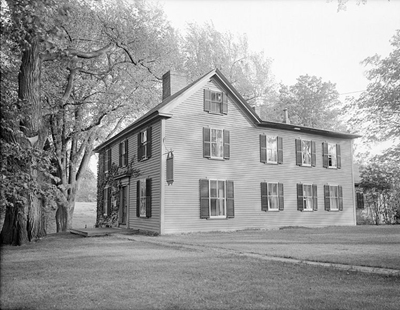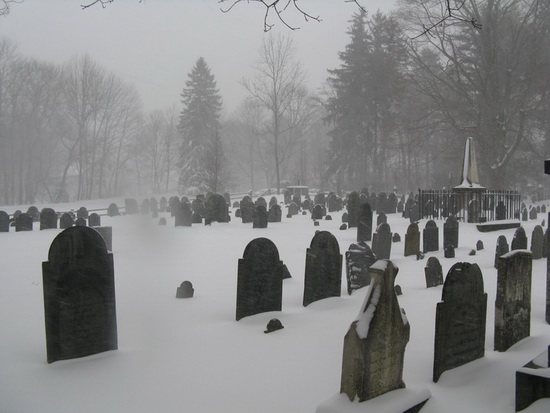Many of the Scots died in that battle; more than ten thousand were captured. Those who could were forced to walk to London where they were herded into prison camps. The men who survived the march were half-starved, living under cramped and disease-infested conditions. Unable to imprison that many for a long period of time, and reluctant to set them free, the government sent the men to overseas colonies to provide slave labor. Some were sent to Virginia, Barbados and the gold mines of Guinea. Two hundred and seventy-two prisoners left England in November 1651 aboard the John and Sara, under Commander John Green. They docked in Boston in early 1652 where the men were sold for £15 to £30 each as indentured servants, earning their freedom after a period of several years.
There were four men in the list of prisoners with the last name Monrow: John, Robert, Hugh and one where the given name was illegible or missing; it is believed that this was William Munroe. William’s indenture was purchased by millwright John Adams in the Menotomy area of Cambridge, Massachusetts; he later worked for and rented land from Joseph Cooke of Cambridge.2
These Scots were not high on the social scale. They were considered to be property and listed in wills and other documents as such, like African slaves. The Puritans disliked them on religious and political grounds. Most spoke Gaelic and could not read or write, and life for these new immigrants was difficult.
By the end of his life, William had done very well considering his earlier banishment from his native land. William was born about 16253 and would have been about twenty-six when he made the voyage to Boston. He finally married in 1665, no longer a young man. His wife was Martha George, daughter of John George, a chimney sweep in Charlestown, who had spent some time in jail for his staunch and vocal Baptist beliefs.
Martha and William had four children - John, Martha, William and George
By this time, William was about 67 years old. He married again, this time to Elizabeth Johnson, widow of Edward Wyer. Elizabeth died in 1715 in Lexington. William made his will a year later and died 27 January 1718. William and his second wife, Mary, were buried in the Old Burying Ground in Lexington.
 William Munroe1 arrived in New England in 1652, but not by choice. William was one of the Scots fighting on the side of the Royalists who were captured in 1651 at the Battle of Worcester by Cromwell’s forces, made to march to London, and subsequently sent, aboard the John and Sara, to Boston, Massachusetts.
William Munroe1 arrived in New England in 1652, but not by choice. William was one of the Scots fighting on the side of the Royalists who were captured in 1651 at the Battle of Worcester by Cromwell’s forces, made to march to London, and subsequently sent, aboard the John and Sara, to Boston, Massachusetts.
 - before Martha died in 1671, about the time that George was born. William then married Mary Ball, about twenty-five years his junior. Mary’s father, John Ball, was a tailor. Her mother, Elizabeth Peirce, went insane. The Ball family lived in Watertown. When her mother was declared insane by the town selectmen and their father abandoned them, the children were farmed out to other families. Mary went to live with her grandparents, John & Elizabeth Pers [Peirce] when she was five.4 After the death of her grandfather in
1661, her mother in 1665 and her grandmother in 1667, Mary was put in the house of Michael and Mary Bacon as a servant. Mary eventually became pregnant with Michael Bacon’s child. Michael was
ordered to raise the child, but Mary was “warned out” of Watertown.5 With nowhere to go, she was
lucky to be taken in by William and Martha George Munroe, by then at Cambridge Farms, now
Lexington. Martha had just had her fourth child and, not long after, she died. Within a year, William married Mary. They had eleven children before Mary died in 1692, age 41. Her father, John Ball, his second wife and an infant child were killed by Indians in the massacre at Lancaster in 1775.
- before Martha died in 1671, about the time that George was born. William then married Mary Ball, about twenty-five years his junior. Mary’s father, John Ball, was a tailor. Her mother, Elizabeth Peirce, went insane. The Ball family lived in Watertown. When her mother was declared insane by the town selectmen and their father abandoned them, the children were farmed out to other families. Mary went to live with her grandparents, John & Elizabeth Pers [Peirce] when she was five.4 After the death of her grandfather in
1661, her mother in 1665 and her grandmother in 1667, Mary was put in the house of Michael and Mary Bacon as a servant. Mary eventually became pregnant with Michael Bacon’s child. Michael was
ordered to raise the child, but Mary was “warned out” of Watertown.5 With nowhere to go, she was
lucky to be taken in by William and Martha George Munroe, by then at Cambridge Farms, now
Lexington. Martha had just had her fourth child and, not long after, she died. Within a year, William married Mary. They had eleven children before Mary died in 1692, age 41. Her father, John Ball, his second wife and an infant child were killed by Indians in the massacre at Lancaster in 1775.
Related Links
Will of William Munroe, d.1718
Images of William Munroe's will
Inventory of estate of William Munroe
Gravestone of William Munroe and Mary Ball, his second wife, on the Find A Grave website
Gravestone of Elizabeth Munroe, William's 3d wife, on the Find A Grave website
Jarvis Peirce Sr. & his wife, Rhoda Darby, a descendant of William & his first wife, Martha George
11-generation descent report for William Munroe, d.1718
Direct descent tree from William Munroe to Jarvis Pierce Jr., son of Rhoda Darby and Jarvis Peirce Sr.
The Munroe Tavern, Lexington, Massachusetts
David Comee, father of John Comee who married William's daughter, Martha Munroe
The Munroe Tavern
The Munroe Tavern sits on a small rise on the east side of Lexington, a landmark in American history. The land it sits on once belonged to John Comee and his wife, Martha Munroe, daughter of the first William Munroe. It was later sold to others, but came back into the Munroe family later on. The Tavern, run by descendants of the first William, was taken over on April 19, 1775, by the British General Earl Percy for about an hour and a half as his headquarters and as a field hospital for those wounded during the fighting at Lexington and Concord on the first day of the Revolutionary War.
Photograph: Munroe Tavern, Massachusetts Avenue, Lexington, Mass., 17 May 1930, by Leon H. Abdalian. From Wikimedia Commons and licensed for reuse under the Creative Commons License.
The Old Burying Ground, Lexington
This cemetery, the oldest in Lexington, dating to 1690, sits northwest of the Lexington Battle Green. William Munroe, his second wife, Mary Ball, and his third wife, Elizabeth Johnson, are buried here. It is not known where William’s first wife, Martha George, was buried.
Photograph: Old Burying Ground, Lexington Massachusetts, 20 December 2009, copyright, John Phelan. From Wikimedia Commons and licensed for reuse under the Creative Commons License.
Although William's Find A Grave memorial, and various websites, give his father's name as Robert Aldie of the Clan Munro of Scotland, there is no airtight evidence for that claim. In a book on the Lexington, Massachusetts, Munroes, by Richard S. Munroe, there is a letter from the Honorable Editor of the Clan Munro Magazine, Robert W. Munro, written October 1965. Despite tradition, and many claims, he notes that, regarding William's orgin, all that can be said is that he was a Scotsman and that he must have been from the Clan Munro. So he must be a descendant, through one of the many lines, of the Barons of Foulis.
History and Genealogy of the Lexington, Massachusetts Munroes, compiled by Richard S. Munroe, Holyoke? Mass., Mansir Press, 1966.
Sources:
Crane, Ellery Bicknell, ed. Historic Homes and Institutions and Genealogical and Personal Memoirs of Worcester County, Massachusetts, vol. I. New York: Lewis Publishing Co., 1907.
Mackenzie, Alexander. History of the Munros of Fowlis. Inverness: A.& W. Mackenzie, 1898.
Rapaport, Diane. “Scots for Sale: The Fate of the Scottish Prisoners in Seventeenth-Century Massachusetts.” New England Ancestors. Winter 2003.
Rapaport, Diane. “Scottish Slavery in 17th-Century New England.” History Scotland. January/Feburary, 2005.
Rapaport, Diane. “Scottish Slaves in Colonial New England.” The Highlander, parts I & II. September/October and November/December 2004.
The Records of the Town of Cambridge (formerly Newtowne), Massachusetts, 1630-1703. Cambridge, 1901.
Watertown Records, Comprising the First and Second Books of Town Proceedings...and the First Book and Supplement of Births Deaths Marriages. Prepared for publication by the Historical Society. Watertown, Mass.: Press of Fred G. Barker, 1894.
Lexington, Mass.: Record of Births, Marriages and Deaths to January 1, 1898. Boston: Wright & Potter Printing Co., 1898.
Website: A Very Grave Matter: http://www.gravematter.com/default.asp (Old Burying Ground, Lexington)
Website: Welcome to Our Stories, by Richard B. Anderson. Information on Mary Ball, the Munroes and others: http://freepages.history.rootsweb.ancestry.com/~timbaloo/. This website has much more detail on William Munroe and Mary Ball.
